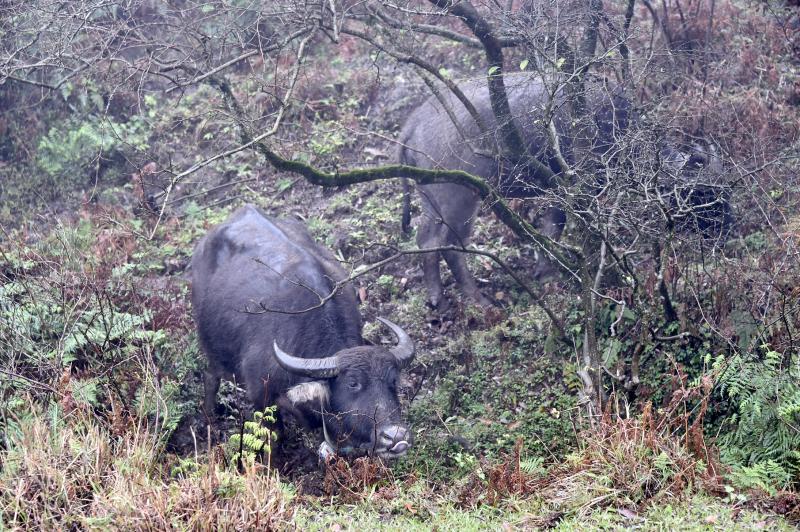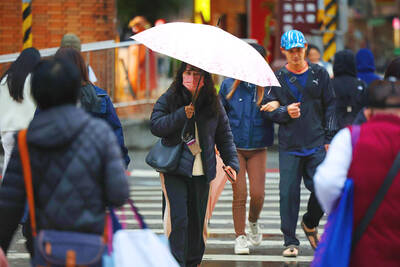The sudden deaths of dozens of wild buffaloes in Yangmingshan National Park over the past four months have triggered questions about their protection and how much human intervention might be necessary.
Since the 1930s, water buffaloes have been grazing on mountain grasslands on Yangmingshan (陽明山), when the Japanese colonial administration set up a pasture in the Qingtiangang (擎天崗) area to graze cattle and other livestock.
In 1952, the government allowed local farmers to use the area as grazing ground for their water buffaloes, which they kept for heavy-duty farm work.

Photo: Tu Chien-jung, Taipei Times
As time passed and water buffaloes were gradually phased out of their traditional role on the nation’s fields, many were abandoned by their owners, but on Yangminshan, they were still looked after by the Taipei Farmers’ Association until 2003.
Since then, the animals have been left to fend for themselves in the wild, roaming and grazing freely on the vast grasslands.
Another change came in October 2019, when the park administration confined the remaining buffaloes within a 42-hectare area, separated by 2.7km of barbed-wire fencing from visitors to the area now popular among hikers.
The fencing was deemed necessary after a woman was in August 2018 rammed to the ground by a buffalo in heat. The woman died from her injuries two weeks later.
About a year after the fence was installed, the buffaloes began dying in large numbers — three in mid-October last year, about 30 in November and last month, and three more in the first 12 days of this month, cutting the population by at least one-third, according to park data.
This is in stark contrast to 2017, 2018 and 2019 when only one buffalo death per year had been registered.
The recent surge of deaths sent officials scrambling for answers.
National Park spokesman Chang Shun-fa (張順發) last month said that the initial findings of an investigation indicated that the buffaloes had died due to malnutrition.
Autopsies of water buffalo carcasses found that the buffaloes had enough grass to eat, but that the grass was not sufficiently nutritious, he said.
The Taipei City Animal Protection Office two weeks after the announcement fined the park headquarters NT$75,000 for failing to “comprehensively address the biological needs of the water buffaloes,” leading to the surge in deaths.
The office said that the fencing left the buffaloes vulnerable to seasonal weather changes, in particular severe winters with constant rains and strong winds, and unable to graze on a larger area, they could not find enough sufficiently nutritious food.
While the park headquarters did not deliberately let the buffaloes die, its negligence resulted in their deaths, the office added.
The park administration disagreed with the conclusion.
Yangminshan National Park Administration Office Director Liu Pei-tung (劉培東) said that some of the buffaloes were found dead in the neighboring Shihtiling (石梯嶺) and Huangzuishan (磺嘴山) areas where no fences were installed.
There were also no signs of any of the dead buffaloes trying to break through the fencing to get to other grazing grounds, he said.
The fenced area featured several ecological systems, including grasslands and valleys, Liu added, without commenting on whether the area provided the necessary nutrition.
The fencing was necessary, because the park headquarters is responsible for striking a “balance between the interests of park visitors and the needs of the buffaloes,” he said.
Liu Chen-hsuan (劉振軒), a professor of veterinary medicine at National Taiwan University, blamed the deaths on aged vegetation and the rainy, cloudy and chilly weather in the past few months, which he said limited the growth of protein-rich young grass.
The rain also washed away minerals deposits, leaving insufficient nutrition for the wild animals, he said.
However, similar conditions have occurred before, without leading to excessive buffalo deaths.
Unable to determine a clear cause of death other than the broad issue of malnutrition, the park headquarters seems baffled as to how to proceed and find a long-term solution.
It took the emergency step of installing salt bricks — bricks enriched with protein and minerals that the buffaloes lick — and placing fodder — a mixture of different grasses.
However, Chang said that the animals, as they are fond grazing the natural grasses of the area, were unwilling to eat the prepared fodder, unless the weather was too bad for them to graze.
In a meeting between park officials and academics on Jan. 6, some wildlife experts suggested gradually moving the buffaloes away from Qingtiangang to more suitable pastures, saying that the the unstable weather on Yangmingshan might not allow the animals to sustain themselves.
However, the experts failed to explain why the buffaloes for several decades could live and breed in the area without problems.
The park said it would hold public hearings to discuss the idea of moving the animals before taking any further steps.

US climber Alex Honnold is to attempt to scale Taipei 101 without a rope and harness in a live Netflix special on Jan. 24, the streaming platform announced on Wednesday. Accounting for the time difference, the two-hour broadcast of Honnold’s climb, called Skyscraper Live, is to air on Jan. 23 in the US, Netflix said in a statement. Honnold, 40, was the first person ever to free solo climb the 900m El Capitan rock formation in Yosemite National Park — a feat that was recorded and later made into the 2018 documentary film Free Solo. Netflix previewed Skyscraper Live in October, after videos

NUMBERS IMBALANCE: More than 4 million Taiwanese have visited China this year, while only about half a million Chinese have visited here Beijing has yet to respond to Taiwan’s requests for negotiation over matters related to the recovery of cross-strait tourism, the Tourism Administration said yesterday. Taiwan’s tourism authority issued the statement after Chinese-language daily the China Times reported yesterday that the government’s policy of banning group tours to China does not stop Taiwanese from visiting the country. As of October, more than 4.2 million had traveled to China this year, exceeding last year. Beijing estimated the number of Taiwanese tourists in China could reach 4.5 million this year. By contrast, only 500,000 Chinese tourists are expected in Taiwan, the report said. The report

Temperatures are forecast to drop steadily as a continental cold air mass moves across Taiwan, with some areas also likely to see heavy rainfall, the Central Weather Administration (CWA) said. From today through early tomorrow, a cold air mass would keep temperatures low across central and northern Taiwan, and the eastern half of Taiwan proper, with isolated brief showers forecast along Keelung’s north coast, Taipei and New Taipei City’s mountainous areas and eastern Taiwan, it said. Lows of 11°C to 15°C are forecast in central and northern Taiwan, Yilan County, and the outlying Kinmen and Lienchiang (Matsu) counties, and 14°C to 17°C

STEERING FAILURE: The first boat of its class is experiencing teething issues as it readies for acceptance by the navy, according to a recent story about rudder failure The Hai Kun (海鯤), the nation’s first locally built submarine, allegedly suffered a total failure of stern hydraulic systems during the second round of sea acceptance trials on June 26, and sailors were forced to manually operate the X-rudder to turn the submarine and return to port, news Web site Mirror Daily reported yesterday. The report said that tugboats following the Hai Kun assisted the submarine in avoiding collisions with other ships due to the X-rudder malfunctioning. At the time of the report, the submarine had completed its trials and was scheduled to begin diving and surfacing tests in shallow areas. The X-rudder,